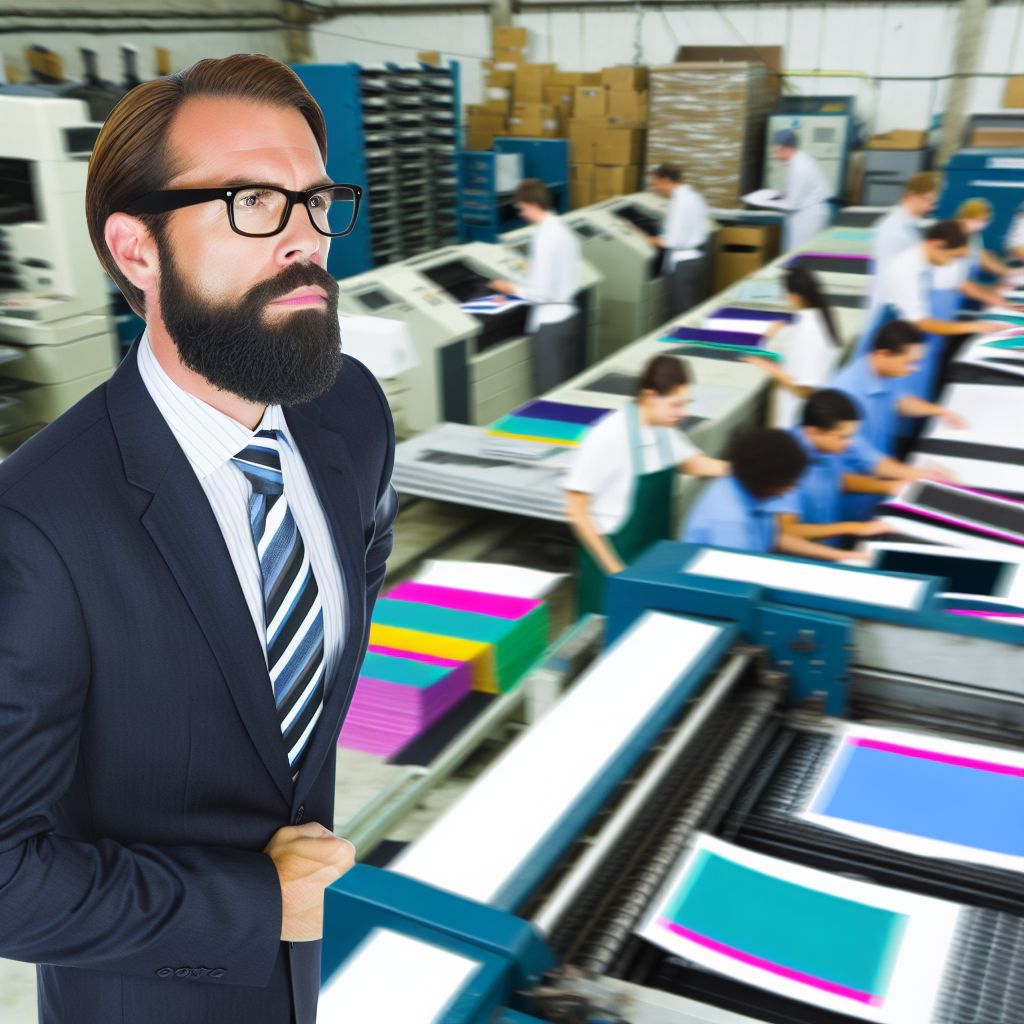Introduction
A Print Production Manager oversees the entire printing process.
They coordinate various printing operations to ensure projects are completed on time and within budget.
Their role encompasses planning, organizing, and managing resources effectively.
This position is crucial in enhancing product quality and efficiency in the printing industry.
The Print Production Manager ensures adherence to industry standards.
They collaborate with designers, clients, and production teams to deliver exceptional printed materials.
By maintaining clear communication, they eliminate misunderstandings and streamline workflows.
Their expertise helps to prevent costly delays and errors.
This blog post explores the role of a Print Production Manager in detail.
We will discuss key responsibilities, essential skills, industry trends, and future challenges.
Understanding these aspects will help aspiring managers navigate this dynamic field.
Key Responsibilities
Print Production Managers handle various tasks daily.
They analyze project requirements alongside clients and design teams.
Budget management falls under their purview, ensuring profitability throughout the process.
They also create production schedules that align with client expectations.
Quality control is a significant aspect of their role.
They review proofs and samples to ensure accuracy and consistency.
Additionally, they troubleshoot any issues that arise during production.
Their problem-solving skills are critical in maintaining workflows and meeting deadlines.
Essential Skills
Success in this role requires strong leadership abilities.
Transform Your Career Today
Unlock a personalized career strategy that drives real results. Get tailored advice and a roadmap designed just for you.
Start NowA Print Production Manager must effectively manage diverse teams.
Excellent communication skills foster collaboration among all stakeholders.
Furthermore, technical knowledge of printing processes and equipment is vital.
Attention to detail and organizational skills ensure high-quality output.
Being adaptable to evolving technology and trends is essential.
Managers often utilize software tools for project management, making tech-savviness important.
Industry Trends and Challenges
The printing industry faces numerous challenges.
Sustainability has become paramount as environmental concerns rise.
Adapting to digital printing technologies also presents challenges.
Print Production Managers must stay informed about these trends to remain competitive.
By understanding their responsibilities and industry dynamics, managers can drive success.
Their role is indispensable in shaping the future of the printing sector.
Becoming a successful Print Production Manager
Becoming a successful Print Production Manager involves understanding various responsibilities that define the role.
These responsibilities play a vital part in ensuring that print projects meet deadlines, stay within budget, and maintain quality standards.
In this section, we will delve into the key duties and obligations that a Print Production Manager must fulfill.
Managing Print Projects from Start to Finish
One of the primary responsibilities of a Print Production Manager is to manage print projects from inception to completion.
This involves several crucial steps:
- Defining project scope and objectives clearly.
- Creating a detailed project plan that outlines resources and timelines.
- Establishing a communication plan to keep all stakeholders informed.
- Monitoring progress regularly to identify potential roadblocks.
- Adjusting project timelines and resources as needed to meet deadlines.
The Print Production Manager ensures that every element aligns with the overall project goals.
They also keep all team members informed and engaged throughout the process.
Showcase Your Business Today
Reach thousands of readers actively exploring professional services. Publish your business profile and grow your audience now.
Publish NowTheir proactive approach helps to minimize surprises as projects evolve.
Overseeing Production Schedules and Deadlines
Production schedules are crucial to any print project’s success.
The Print Production Manager takes charge of this aspect by:
- Creating realistic timelines based on project needs.
- Prioritizing tasks to ensure efficient workflow.
- Tracking production milestones to ensure adherence to schedules.
- Maintaining flexibility to respond to unforeseen challenges.
- Communicating with the production team about deadlines and deliverables.
By overseeing production schedules diligently, Print Production Managers can help prevent last-minute rushes.
They facilitate smoother operations, allowing projects to flow seamlessly from one phase to the next.
Collaborating with Designers, Printers, and Clients
Effective collaboration stands at the core of a Print Production Manager’s role.
This collaboration includes engaging with various stakeholders to ensure everyone is on the same page.
Responsibilities here involve:
- Meeting with designers to review conceptual ideas and layouts.
- Interfacing with printers to discuss technical specifications and capabilities.
- Gathering client feedback to refine designs and proposals.
- Participating in regular status meetings to promote transparency and accountability.
- Gathering input from the production team to enhance processes.
Collaborating with these crucial players ensures the project stays aligned with client expectations.
It also allows for creative solutions to emerge during the production process.
This dynamic engagement fosters innovation while maintaining quality.
Ensuring Quality Control and Cost Efficiency
Quality control is an essential aspect of print production.
The Print Production Manager holds the responsibility for maintaining high standards by:
- Implementing quality assurance processes at various production stages.
- Conducting regular inspections to ensure adherence to quality benchmarks.
- Tracking production metrics to identify areas for improvement.
- Providing feedback to the team to address quality issues proactively.
- Educating the team about best practices in quality management.
In the world of print, cost efficiency is equally important.
A Print Production Manager must also:
- Establishing a budget for each print project at the outset.
- Monitoring expenditures to avoid overspending.
- Negotiating contracts with suppliers and vendors to secure favorable rates.
- Identifying cost-saving opportunities without sacrificing quality.
- Regularly reviewing production processes to enhance efficiency.
By focusing on quality control and cost efficiency, Print Production Managers help deliver projects that meet expectations.
Their efforts ensure that the final product is not only visually appealing but also economically viable.
The Impact of a Print Production Manager
The role of a Print Production Manager encompasses a variety of critical responsibilities.
By managing projects from start to finish, overseeing schedules, and collaborating with key stakeholders, they ensure successful outcomes.
Their commitment to quality control and cost efficiency plays a vital role in the printing industry.
As the landscape continues to evolve, the Print Production Manager must adapt to new technologies and trends.
This adaptability enhances their ability to guide projects effectively in a competitive market.
Ultimately, the expertise of a Print Production Manager leads to high-quality prints that reflect both the client’s vision and the standards of the printing industry.
Through the lens of their responsibilities, it is evident that Print Production Managers are indispensable in achieving success in print production.
They thread together creativity, logistics, and management skills to create stunning printed materials that leave a lasting impact.
Essential Skills and Qualifications for Print Production Managers
In today’s fast-paced printing industry, a Print Production Manager plays a vital role.
This position requires a unique blend of skills and qualifications.
Here are the essential skills and qualifications you’ll need to excel in this career.
Strong Organizational Skills
Organizational skills are crucial for every Print Production Manager.
You must manage multiple projects simultaneously.
This entails overseeing timelines, budgets, and resources.
Creating efficient workflows is another essential responsibility.
Proper organization reduces errors and prevents delays.
Here are some organizational tasks you will often handle:
- Managing project schedules and deadlines
- Coordinating with different departments, such as design and marketing
- Tracking inventory and materials
- Ensuring compliance with quality standards
- Maintaining detailed records of each project
Project Management Skills
Along with organization, strong project management skills are vital.
You must plan, execute, and close projects effectively.
Understanding project management methodologies adds significant value to your role.
Common project management tasks include:
- Setting clear goals and objectives for each project
- Allocating resources efficiently
- Monitoring project progress with KPIs
- Identifying and mitigating risks
- Conducting post-project evaluations
Emphasizing a proactive approach aids in anticipating challenges.
This foresight ensures smoother operations.
Showcase Your Business Today
Reach thousands of readers actively exploring professional services. Publish your business profile and grow your audience now.
Publish NowKnowledge of Printing Processes and Technologies
A deep understanding of printing processes is essential for a Print Production Manager.
You should be familiar with various printing techniques, such as offset, digital, and flexography.
Each method has its unique strengths and applications.
You need to assess the right process for each project.
Additionally, you must stay updated on emerging technologies and software trends.
Important knowledge areas in this field include:
- Color management and proofing techniques
- Finishing techniques like binding and laminating
- Prepress processes including file preparation and printing plates
- Post-press production methods
- Sustainability practices within printing
Understanding these technologies helps you make informed decisions.
It enhances the quality of the final product while optimizing costs.
Excellent Communication Skills
Communication is a vital skill for a Print Production Manager.
You will work with team members, clients, and vendors.
Effectively conveying ideas and instructions is crucial.
Strong communication ensures that everyone is on the same page.
It fosters collaboration and mitigates misunderstandings.
Key areas for effective communication include:
- Writing clear and concise project briefs
- Presenting project updates to clients and stakeholders
- Negotiating with suppliers and vendors
- Facilitating regular team meetings to discuss progress
- Providing feedback to team members to improve processes
Problem-Solving Abilities
Every project comes with its challenges.
A Print Production Manager must possess strong problem-solving abilities.
When you encounter issues, it’s essential to think critically and creatively.
Quickly identifying problems and exploring solutions is vital.
This ability minimizes disruptions and keeps projects on track.
Your problem-solving skills will often be tested in areas such as:
- Resolving production bottlenecks
- Troubleshooting equipment malfunctions
- Adapting to last-minute client changes
- Managing tight deadlines under pressure
- Ensuring compliance with safety and regulatory standards
Experience in the Printing Industry or Related Fields
Experience plays a significant role in shaping your ability as a Print Production Manager.
Familiarity with the printing industry enhances your operational knowledge.
Gaining experience in various roles within the industry proves invaluable.
This experience provides insights into everyday challenges and best practices.
Here are some positions that can prepare you for this role:
- Prepress Technician
- Press Operator
- Print Finishing Specialist
- Production Coordinator
- Quality Control Inspector
Working in diverse roles helps you build a comprehensive understanding of the production process.
You learn from each experience, enabling you to lead more effectively.
Continuous Learning
The printing industry is continually evolving.
As a Print Production Manager, you must embrace ongoing education.
This involves keeping abreast of the latest technologies and trends.
Participating in workshops, seminars, and industry conferences is essential.
Additionally, you may consider obtaining certifications.
Many organizations offer professional development programs.
Some beneficial certifications include:
- Certified Printing Manager (CPM)
- Digital Workflow Specialist
- G7 Expert Certification
- Lean Six Sigma Certification
- ISO 9001 Quality Management Certification
Engagement in continuous learning ensures you stay relevant.
It equips you to implement innovative solutions that drive efficiency and productivity.
Discover More: Educational Pathways for Corporate Communications Careers
Industry Trends and Developments
In the world of print production, significant changes continue to shape the industry landscape.
Technologies evolve rapidly, introducing both challenges and opportunities.
Print production managers must remain vigilant and adaptable to these shifts.
Showcase Your Business Today
Reach thousands of readers actively exploring professional services. Publish your business profile and grow your audience now.
Publish NowHere are a few crucial trends influencing today’s print industry:
Impact of Digital Technologies on Print Production
The rise of digital technologies has revolutionized print production.
It has transformed how businesses design, produce, and distribute printed materials.
Key elements of this digital transformation include:
- On-demand printing: Digital printing allows for lower print runs and faster turnaround times, catering to the market’s need for personalization.
- Enhanced designs: Software tools enable graphic designers to create intricate and unique designs more efficiently.
- Easy integration: Digital technologies integrate seamlessly with online marketing strategies, enhancing overall promotional efforts.
- Data-driven decisions: Advanced analytics tools help print managers assess performance and improve marketing campaigns based on consumer behavior.
These advancements often lead to increased efficiency and cost savings.
Companies that invest in digital technologies can respond more rapidly to market demands.
Sustainability and Eco-friendly Practices in Printing
Environmental awareness has grown in the print industry.
Businesses now recognize the importance of sustainability.
They strive for eco-friendly solutions in their processes.
Consider the following practices:
- Recycled materials: Utilizing recycled paper and sustainable resources minimizes waste and supports ecological balance.
- Eco-friendly inks: Water-based and soy-based inks reduce toxic emissions and lessen environmental impact.
- Energy-efficient machinery: Investing in energy-efficient printing equipment reduces energy consumption while maintaining productivity.
- Waste reduction programs: Implementing recycling programs fosters responsible disposal and renewable practices.
By focusing on sustainability, print production managers can attract environmentally conscious customers.
They demonstrate corporate responsibility while complying with increasing regulations.
Automation and AI in Print Production Processes
Automation and artificial intelligence (AI) significantly change production workflows.
These technologies enhance efficiency and accuracy.
Key advantages include:
- Workflow automation: Automating routine tasks minimizes human error and accelerates the production process.
- Predictive maintenance: AI systems monitor equipment health, predicting failures before they happen. This capability avoids costly downtime.
- Personalization: AI can analyze data to tailor marketing materials, increasing engagement through targeted messaging.
- Inventory management: Advanced algorithms optimize inventory, ensuring the right materials are available when needed.
As companies embrace these technologies, they foster improvements in productivity and operational efficiency.
Print managers who adopt AI and automation will likely see greater success in meeting customer demands.
Opportunities for Growth and Advancement in the Field
The print production industry continues to evolve, presenting numerous growth opportunities.
Print production managers should consider the following factors:
- Skill development: Ongoing training ensures managers stay abreast of new technologies and practices. They can advance their careers by mastering new skills.
- Innovation adoption: Collaborating with technology providers fosters innovation. Managers can leverage emerging technologies for competitive advantages.
- Networking: Participating in industry events allows managers to connect with peers and share insights. This networking can lead to partnerships and collaborations.
- Diverse market demand: Expanding print services to include packaging, signage, or promotional materials can tap into new revenue streams.
With keen awareness of these trends, print production managers can position themselves for strategic opportunities.
The future of the print industry is bright for those willing to adapt and innovate.
See Related Content: Content Strategist vs. Content Marketer: Key Differences
Print production managers play a vital role in the printing industry.
They ensure that projects align with client expectations while adhering to quality standards.
However, they face several challenges that can impact their overall effectiveness.
Below, we explore some of these challenges in detail.
Meeting Tight Deadlines and Client Expectations
One of the primary challenges print production managers face is meeting tight deadlines.
The fast-paced nature of the printing industry often requires managers to juggle multiple projects simultaneously.
- Time Management: Effective time management is crucial in ensuring that all tasks are completed on schedule.
- Prioritization: Production managers often deal with competing priorities.
- Client Communication: Clear communication with clients about deadlines is essential.
- Resource Allocation: Managers must ensure that they have the right resources available.
Balancing Quality and Cost Considerations
Another significant challenge involves balancing quality with cost considerations.
Print production managers often operate under tight budget constraints while striving to maintain high-quality output.
- Quality Assurance: Ensuring quality in print production is non-negotiable.
- Cost Management: Managers need to analyze costs systematically.
- Supplier Relationships: Cultivating positive relationships with suppliers can help managers negotiate better prices.
- Technological Investment: Investing in advanced printing technology can raise initial costs but ultimately lower long-term expenses.
Handling Unforeseen Issues and Troubleshooting
Print production managers frequently encounter unforeseen issues that require immediate attention.
These issues can arise at any stage of the production process.
- Equipment Malfunctions: Equipment failures can bring production to a halt.
- Material Shortages: Sudden shortages of essential materials can disrupt timelines.
- Unexpected Changes: Client changes in specifications can pose challenges.
- Team Dynamics: Disputes among team members can affect productivity.
Keeping Up with New Technologies and Industry Changes
In a rapidly evolving industry, print production managers must stay updated on new technologies and trends.
The introduction of new techniques can significantly impact production efficiency.
- Continuous Learning: Managers should engage in ongoing education.
- Vendor Partnerships: Collaborating with technology vendors can provide practical insights.
- Software Integration: Managers need to adapt to new software solutions that enhance workflow efficiency.
- Consumer Preferences: Changes in consumer preferences can influence print production processes.
See Related Content: Press Secretary’s Guide to Crisis Management

Stay Organized and Prioritize Tasks Effectively
Organization is vital in the fast-paced world of print production.
Here are some practical ways to maintain order:
- Create a detailed project timeline. Utilize project management tools to set deadlines and track progress.
- Implement a task management system. Use digital tools to assign tasks, set priorities, and monitor workflows.
- Maintain an organized workspace. A tidy office helps reduce distractions and increases efficiency.
- Review priorities regularly. Assess the urgency of tasks daily and adjust your focus accordingly.
- Utilize checklists. These visual aids remind you of important tasks and hold you accountable.
Effective prioritization ensures that critical tasks are completed on time.
Consider using the Eisenhower Matrix to categorize tasks by urgency and importance.
This method can help identify which tasks require immediate attention and which can be scheduled for later.
Showcase Your Business Today
Reach thousands of readers actively exploring professional services. Publish your business profile and grow your audience now.
Publish NowCommunicate Clearly and Collaborate with Team Members
Strong communication fosters a collaborative environment.
Implement these best practices to enhance team dynamics:
- Schedule regular team meetings. Weekly check-ins facilitate open communication and provide opportunities for feedback.
- Encourage an open-door policy. Ensure team members feel comfortable approaching you with questions or concerns.
- Utilize collaborative tools. Platforms like Slack and Microsoft Teams can aid quick conversations and document sharing.
- Practice active listening. Show your team you value their input by acknowledging their ideas and concerns.
- Provide clear instructions. Detail expectations for tasks and projects to avoid misunderstandings.
Effective collaboration leads to a more cohesive team.
Regular communication makes it easier to share insights, solve problems, and achieve goals as a united group.
Encourage input from all team members; diverse perspectives can spark creativity and innovation.
Continuously Update Skills and Knowledge in Printing
The printing industry evolves rapidly, making continuous learning essential.
Stay competitive by following these strategies:
- Attend industry conferences. Events like Print 22 offer valuable networking opportunities and educational sessions.
- Enroll in online courses. Platforms like Coursera and LinkedIn Learning offer courses on the latest printing technologies.
- Join professional organizations. Groups such as the Printing Industries of America provide resources and training opportunities.
- Subscribe to industry publications. Magazines and journals keep you informed about trends and best practices.
- Participate in webinars and workshops. These events offer insights from industry experts and allow real-time Q&A sessions.
Upgrading skills not only enhances personal performance but also benefits the entire team.
By sharing knowledge, you contribute to a culture of constant improvement.
Staying informed about new technologies can also lead to innovative solutions for current challenges.
Build Strong Relationships with Clients and Vendors
Strong relationships are the backbone of successful print production management.
Focus on these strategies to cultivate connections:
- Communicate regularly with clients. Regular updates on project statuses prevent misunderstandings and build trust.
- Solicit feedback. Actively request client input to improve services and demonstrate that their opinions matter.
- Offer personalized service. Tailor your approach to meet each client’s unique needs and preferences.
- Nurture vendor relationships. Make an effort to understand their capabilities and challenges, fostering mutual respect.
- Follow up after a project’s completion. Show appreciation for their business and address any residual concerns.
Developing these relationships results in a more seamless production process.
Trusted vendors can provide quicker turnarounds and enhanced support.
Satisfied clients are more likely to return for future projects and refer others to your services.
Leverage Technology to Improve Processes
Technology is reshaping the printing landscape.
Here are ways to harness its potential:
- Invest in digitalization. Transition to digital workflows to increase efficiency and reduce paper waste.
- Utilize project management software. Tools like Asana and Trello help streamline workflows and improve transparency.
- Adopt automation tools. Automate repetitive tasks to free up time for more strategic work.
- Incorporate data analytics. Use analytics to track production metrics and identify areas for improvement.
- Stay updated on printing technologies. Keep abreast of advancements such as 3D printing and eco-friendly materials.
Embracing technology can set your operation apart from competitors.
Assess your processes regularly to find opportunities for integration.
A proactive approach to technology can lead to improved quality and efficiency in your production cycle.
See Related Content: Networking Tips for Content Creators
Career Overview of a Print Production Manager
When exploring the career of a Print Production Manager, several factors come into play.
Understanding salary expectations, the job outlook, and advancement opportunities helps job seekers make informed decisions.
This section will cover the average salary range, job growth prospects, and pathways for career advancement in this field.
Average Salary Range in the Printing Industry
Print Production Managers earn a competitive salary in the industry.
Their pay often reflects their experience, skills, and responsibilities.
Here are some key points about their income:
- The average salary for Print Production Managers typically ranges from $60,000 to $90,000 annually.
- Factors such as location, company size, and industry specialty influence salaries significantly.
- Entry-level positions may start as low as $45,000, while highly experienced managers can earn over $100,000.
- In metropolitan areas, salaries often edge higher due to the cost of living and demand for skilled workers.
Beyond base salaries, many companies offer additional forms of compensation.
These may include bonuses, healthcare benefits, and retirement plans.
Print Production Managers often attract more comprehensive packages as they advance in their careers.
Understanding these nuances allows prospective managers to negotiate better contracts and salaries.
Job Growth and Demand for Skilled Print Production Managers
The printing industry is evolving.
This evolution includes technological advancements and changing consumer behaviors.
As a result, the demand for skilled Print Production Managers remains robust.
Here are some essential insights:
- The Bureau of Labor Statistics projects a growth rate of about 2% for this occupation over the next decade.
- Despite the overall decline in traditional print media, there is a steady demand for promotional materials and packaging.
- Companies increasingly require managers with expertise in digital printing and production technologies.
- Skilled Print Production Managers can find opportunities in various sectors, including marketing, publishing, and e-commerce.
This growth is influenced by several trends:
- Shift towards short-run and on-demand printing, which requires efficient production management.
- Increased customization requests, which necessitate skilled oversight during production.
- Emergence of sustainable printing practices, requiring knowledgeable managers to implement eco-friendly strategies.
Understanding these trends helps aspiring managers position themselves effectively in the workforce.
Keeping abreast of industry changes will ensure they remain competitive.
Opportunities for Advancement into Higher Roles or Management Positions
Print Production Management offers diverse career advancement options.
As professionals gain experience, they may pursue several pathways.
Showcase Your Business Today
Reach thousands of readers actively exploring professional services. Publish your business profile and grow your audience now.
Publish NowHere is a breakdown of potential career growth trajectories:
- Senior Print Production Manager: After several years in a management role, professionals can move into senior positions, overseeing larger teams and budgets.
- Operations Manager: With a broader understanding of operational dynamics, some managers transition into operations roles, managing entire production facilities.
- Director of Production: This is a high-level position responsible for strategic planning and execution across multiple departments.
- Vice President of Manufacturing: Experienced professionals can ascend to executive management, shaping company-wide production strategies.
Beyond moving up the corporate ladder, Print Production Managers can also explore specialized roles:
- Quality Control Manager: This role focuses on ensuring that print quality meets industry standards and client expectations.
- Project Manager: Managers can shift towards project management, overseeing specific printing contracts, timelines, and budgets.
- Consultant or Entrepreneur: Experienced managers may opt to become consultants, advising businesses or starting their own print-related enterprises.
Building a professional network significantly enhances advancement opportunities.
Attending industry conferences, seminars, and workshops can foster connections.
Active participation in industry associations also opens doors to new opportunities.
Implications for Aspiring Print Production Managers
The career of a Print Production Manager presents a promising and rewarding path.
With an average salary range that reflects experience and location, it is a viable option for many.
Although the job growth rate remains modest, demand persists.
This is especially true for skilled professionals embracing technological changes.
Advancement opportunities abound, allowing dedicated individuals to climb the career ladder.
Engaging in continuous learning and networking significantly enhances one’s prospects in this dynamic field.
Print Production Management Overview
In this blog post, we explored several key points about print production management.
First, we defined the role of a Print Production Manager. Their responsibilities include overseeing the printing process from start to finish.
Second, we discussed the necessary skills for success. Strong communication, organization, and technical proficiency are essential traits.
Additionally, we highlighted the importance of understanding industry trends. Staying informed about technological advancements can drive efficiency and innovation.
Third, we examined the challenges faced in the industry. Print Production Managers must navigate tight deadlines and varying client expectations.
Moreover, we acknowledged the vital role they play in maintaining quality standards. Their attention to detail ensures that final products meet client requirements.
Furthermore, successful managers build strong relationships with suppliers and clients. These relationships often lead to repeat business and positive referrals.
In the context of environmental sustainability, Print Production Managers increasingly focus on eco-friendly practices. These initiatives are becoming essential in maintaining a competitive edge.
Print Production Managers are crucial to the printing industry. They streamline operations while ensuring quality and client satisfaction.
As we wrap up our discussion, we encourage aspiring professionals to consider a career in print production management. This field offers a dynamic and rewarding work environment.
With a commitment to ongoing education and skill-building, one can thrive in this exciting industry. The future of print production is bright, and it needs passionate individuals to drive its progress.
Additional Resources
Tag: Global Omnichannel Marketing Production Agency
[E-Books for Sale]
The Big Book of 500 High-Paying Jobs in America: Unlock Your Earning Potential
$19.99 • 500 High-Paying Jobs • 330 pages
Explore 500 high-paying jobs in America and learn how to boost your career, earn more, and achieve success!
See All 500 High-Paying Jobs of this E-Book
1001 Professions Without a Degree: High-Paying American Jobs You Can Start Now
$19.99 • 1001 Professions Without a Degree • 174 pages
Discover 1001 high-paying jobs without a degree! Unlock career tips, skills, and success strategies for just $19.99!




